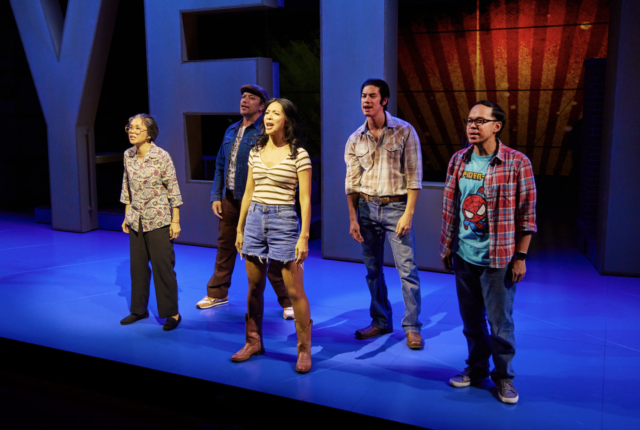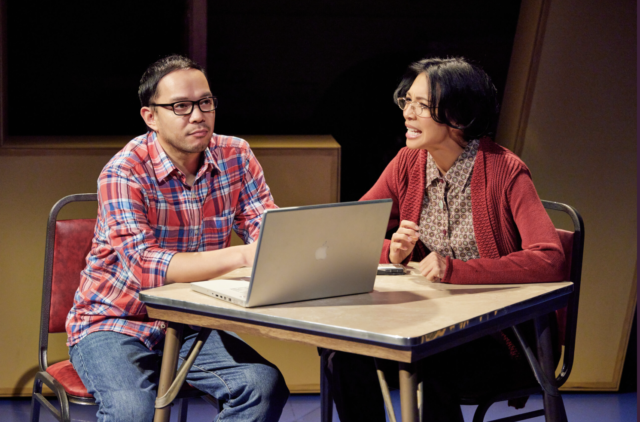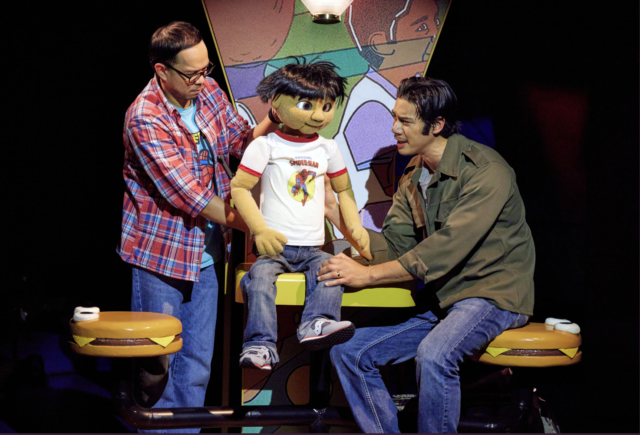
The cast of Poor Yella Rednecks occasionally breaks out into hip-hop songs (photo by Jeremy Daniel)
POOR YELLA REDNECKS
MTC at New York City Center – Stage I
131 West Fifty-Fifth St. between Sixth & Seventh Aves.
Tuesday – Sunday through December 3, $89-$109
212-581-1212
www.manhattantheatreclub.com
www.nycitycenter.org
Arizona-born Vietnamese American playwright and screenwriter Qui Nguyen follows up his semiautobiographical Vietgone with Poor Yella Rednecks, making its New York premiere at MTC at New York City Center — Stage I through December 3.
In praising Vietgone, I wrote, “Passionately directed by [May] Adrales with a frenetic warmth, the hip-hop immigrant tale — with a sweet nod to Hamilton — is colorful and energetic.” I am happy to say the same thing about Poor Yella Rednecks, except it’s even better than its predecessor.
Once again, the play begins with Nguyen (Jon Norman Schneider), called the playwright, explaining that not everything we are about to see actually happened. “This story is based on true events. All heavily researched. All one hundred percent historically accurate. Well, at least according to my mom.”
It’s August 7, 2015, and Nguyen is sitting at a table, interviewing his mother, Tong (Maureen Sebastian), for a play about how she left Vietnam and began a new life in America. But she thinks it’s a terrible idea and the reason why he is poor. “No one want to hear story about old woman who speak bad English with bald son,” she says. She ultimately agrees to talk with him but with a few important rules: “I don’t want you to only tell happy thing. I see your other play. You like to write romantic and funny. But no life is all romance. And it is not all fun. Sometimes it is hard. We Vietnamese. We good at being hard. I want it to be true and hard.” Another rule relates to speech: “If this going to be my play, I want all the white people to sound like the way I hear them. Let them hear all the stupid stuff they say. . . . And finally, I want to talk good.”
Thus, when Vietnamese characters speak with each other, it is in perfect English, substituting for Vietnamese so the audience can understand what they’re saying. But when a Vietnamese character is actually speaking English, it is in broken English. For example, when the older Tong talks to her son in broken English, that is how she is pronouncing the language; however, when she speaks in perfect English, she is actually talking to him in Vietnamese. It’s handled beautifully by Adrales and the cast, a constant reminder of the immigrant experience.
Tong takes him back to Arkansas in 1975, when she met her future husband, Nguyen’s father, Quang, at a relocation camp named Fort Chaffee, then moved to El Dorado. When the playwright says that it must have been love at first sight, Tong replies, “Mm-hmm. And Santa Claus is real, as is the Easter Bunny, and capitalism works for everybody.”

The playwright (Jon Norman Schneider) interviews his mother (Samantha Quan) in Poor Yella Rednecks (photo by Jeremy Daniel)
The action then shifts to the past as Tong and Quang (Ben Levin) fall in love even though she is still dating Bobby (Paco Tolson) and he is still married to Thu (Samantha Quan), who is raising their two children in Vietnam. Five years later, Quang and Tong are living in a trailer with her mother, Huong (Quan), a foul-mouthed, cynical smoker who takes care of Quang and Tong’s son, Little Man, while Tong works at a local diner and Quang hangs out with his hapless friends, including his bestie, Nhan (Jon Hoche). In an ingenious move, Little Man is a puppet, designed by David Valentine, that is voiced and operated by Schneider as the playwright, essentially the adult son playing himself as a child. It works wonderfully, especially when Huong teaches Little Man how to defend himself.
When Nhan announces that he’s moving to Houston to find better opportunities and it turns out that Quang hasn’t quite settled things with Thu yet, Tong starts to reevaluate who she is and what she wants out of life.
Tim Mackabee’s set is structured around five large neon letters — Y, E, L, L, A — that occasionally light up in different colors and are moved around to expose smaller sets attached to them, from a living room and a bar to the diner and a fast-food joint. They were designed to evoke the letters in the fabled Hollywood sign; just as that sign beckons wannabe stars to California from all over the world, the Y-E-L-L-A letters represent the American dream that Asians have when they emigrate from their countries to the United States — and encounter hatred, bigotry, language barriers, and other elements that do not make their transition easy. Several scenes also occur in and around a pickup truck, revealing that the vehicle is a favorite not only for a certain stereotyped group of white men who like country music and beer.
The big letters, along with comic-book-like projections by Jared Mezzocchi, are also a nod to Nguyen’s success as a writer for Marvel Studios and founder of the New York–based Vampire Cowboys troupe; Nguyen even has Marvel legend Stan Lee (Tolson, who portrayed the playwright in Vietgone) show up once in a while and deliver statements about heroes. Valérie Thérèse Bart’s costumes hit their target, and Lap Chi Chu’s lighting ranges from bold to intimate.
As in Vietgone, the cast, nearly all of whom appeared in that show at South Coast Rep and/or MTC, displays their vast talents by often breaking out into exciting raps; the original music is by sound designer Shane Rettig, arranged by Kenny Seymour, choreographed by William Carlos Angulo, and with music direction by Cynthia Meng. “I know you think I’m joking — what the hell am I smoking? / But being next to you is what got my heart thumping / Our kiddies will be cuties, bring over that fine bootie / Nothing’s gonna stop us with our combined beauty,” Quang declares. “Let me reintroduce myself / I’m better known as that shorty that you up and left / I must be crazy, baby — thought you were dead / We threw a funeral to commemorate your death,” Thu announces. “Cuz I’m more than just pretty, my brain is damn witty / Gimme one hot second — Imma run this city / Yo, say that I shouldn’t — I’m my own woman / Stronger than any man and twice as good looking,” Tong proclaims. “Even if they mad at you, you gotta be true to you / Every scar you wear, you show the shit that you went through / Ya gotta stand strong, be strong, head strong, ya ain’t wrong / So come on listen close, this here’s our fight song,” Huong tells Little Man.

Jon Norman Schneider (left) portrays the playwright and his younger puppet self in New York premiere from MTC (photo by Jeremy Daniel)
Nguyen (She Kills Monsters, Living Dead in Denmark) and Adrales (The Strangest, Golden Shield) are in total sync; nearly every minute rings true, and the pace never lags. Schneider (The Coast Starlight, Once Upon a (korean) Time) is warm and charming as the playwright, Hoche (King Kong, Life of Pi) is a hoot as Nhan and various rednecks, Levin is hunky as Quang, Quan is cute and lovable as Huong, Tolson (The Knight of the Burning Pestle, Children of Vonderly) gives Bobby an unexpected edge, but Sebastian (The Best We Could: A Family Tragedy, Soul Samurai) steals the show as Tong, who stares adversity right in the face but refuses to give up, in many ways representing the Asian diaspora in America.
Early on, right before the official interview begins, Tong tells her son, “Let me tell you what kind of story white people want to hear.” He asks, “Wait, why only ‘white people?’” She replies, “Because only white people like to watch a play.” He argues, “All sorts of people watch plays, Mom.” To which she counters, “Yes, all sorts of white people. It look like a Fleetwood Mac concert. It so white. . . . Maybe I don’t want to dig up old history just so you can make a few dollar on play white people won’t like.”
At the matinee I saw, the audience appeared to be at least half Vietnamese or Vietnamese American, both young and old, and they and the white people reacted in unison to the unconventional, important story taking place onstage. Eliciting a wide range of emotions, the show accomplishes what theater does best, bringing people of different backgrounds together to focus on the human condition, reaching into the past while giving us hope for the future.
[Mark Rifkin is a Brooklyn-born, Manhattan-based writer and editor; you can follow him on Substack here.]